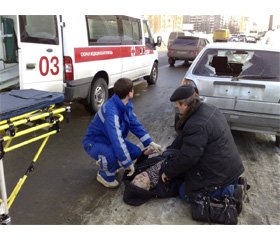Журнал «Травма» Том 16, №2, 2015
Вернуться к номеру
Analysis of Using Medical Diagnostic Technologies in Victims of Traffic Accidents in a City Hospital
Авторы: Guriev S.O., Satsyk S.P., Yevdoshenko V.P., Natsevych R.O. - State Institution «Ukrainian Scientific and Practical Center of Emergency Care and Disaster Medicine of Ministry of Healthcare of Ukraine», Kyiv, Ukraine
Рубрики: Травматология и ортопедия
Разделы: Клинические исследования
Версия для печати
trauma, traffic accident, injury, diagnostic.
Introduction. Last decades are characterized by considerable increase in traumatism, in the structure of which dominates limbs injuries, especially the long bones. In modern conditions, the organization of diagnostic measures and medical care to victims of polytrauma with long bones injuries needs improvement.
The aim of the study was to analyze the use of modern medical diagnostic technologies of injuries in victims due to the traffic accidents.
Materials and methods. We have investigated the diagnostic process in 139 patients with polytrauma with long bone injuries due to traffic accidents, who were treated at the Poltava city hospital № 1. The analysis included studying the primary clinical professional examination of the victim on admission to hospital, of radiological research, of ultrasonographic research and of computed tomography research.
Results. It was established that primary clinical professional examination during the first 20 minutes received only 50.36% of patients, for 20-40 minutes - 39.57% of patients and during 40-60 minutes — 10.07% of the victims. These trends indicates that primary clinical professional examination does not have a decisive influence on the outcome of traumatic process, but the main thing is execution protocol measures.
The 99.28% of patients required radiological research. The radiological research was held in 30.94% during first 30 minutes, in the period 30-60 minutes - 54.67%. During the second hour, the radiological research was held in 11.51%, and after the second hour - 2.16% of patients. Thus, it should be noted that the radiological research is conducted not optimal, which reduces its clinical efficacy.
Ultrasonographic examination performed only to 29.5% of patients, while only 13.67% it was done during the first six hours of moment of receipt. Another 8.63% of patients ultrasonographic research was performed in the period 6-12 hours after receipt. Thus, of ultrasonographic research in patients with polytrauma due to traffic accidents is not optimal and adequate in terms of time.
The computed tomography research was held in 59.71% of patients. During the first hour the computed tomography research was not held. During the second hour of receipt the computed tomography research was held in 7.91% of patients, during the third hour - 24.46%, in time more than three hours - 27.34%. This indicates that the level of timeliness of the computed tomography research is an important factor that affects the result of traumatic process, and is not optimal due to lack of amount of research of victims.
Conclusions. 1. Fractures of the long bones of victims of the traffic accidents are usually a component of polysystemic damage requires examination of several organs and systems, leading to delay implementation of adequate treatment. 2. The use of modern medical technology for diagnostics of injuries of victims due to the traffic accidents in urban hospitals is insufficient in volume and not optimal and adequate in terms of time. 3. Untimely and lack of purposefulness of diagnostic measures is one of the reasons that reduces the effectiveness of medical interventions in patients with long bone fractures due to the traffic accidents, which in turn leads to a very high lethality of victims.

